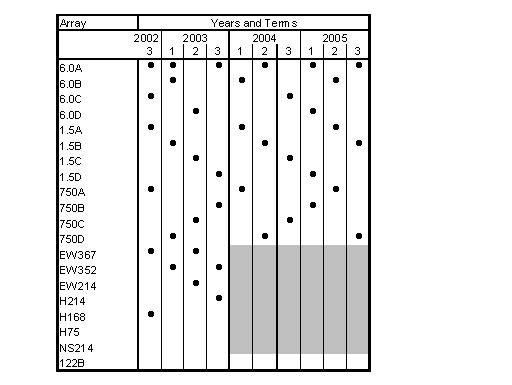Time assignment information
ATCA information
The interim 3- and 12-mm systems on three antennas continue to be offered. Given that these systems are still immature, proposals for these must include an ATNF staff member, who is expected to be conversant with the millimetre systems. The millimetre bands remain divided into two sub-bands (16.1 - 18.9 and 20.1 - 22.5 GHz at 12 mm, and 84.9 - 87.3 and 88.5 - 91.3 GHz at 3 mm) with a physical swap of hardware in the antenna vertex room needed to switch between the sub-bands.
In 2002SEPT the new configuration H168 (using the north spur) is being offered for the first time. This is in addition to the 6.0A, 1.5A, 750A and the new EW367 configurations. The term will also start with the 6C array. Observers are invited to propose projects using any of these configurations.
Proposals are solicited to use the interim 12-mm and 3-mm systems available on three of the ATCA telescopes. For this term the millimetre systems are provided on a shared risk basis, and proposals must include an ATNF staff collaborator. The staff member is expected to understand the use and capabilities of the mm systems. To help optimize Fourier coverage with three antennas, antennas will be "shuffled" in the EW367 configuration.
Table 1 gives the proposed array configurations being offered over the coming years. The details of this are different to a proposal presented at the last ATUC meeting, although the principles behind them remain unchanged. The change from the ATUC meeting is the result of an error in meshing the previously advertised configurations with future configurations. As millimetre usage is going to change the array usage patterns, we have yet to determine compact configurations beyond 2003.
Apart from VLBI and VSOP use, there is unlikely to be any scheduled Mopra time in the September term. The next call for proposals for Mopra will be in February 2003.

Table 1: Proposed array configurations for the next few years
Availability of Tidbinbilla 70-m telescope for spectroscopy
As part of the Host Country agreement with NASA, a fraction of time on the Tidbinbilla 70-m antenna is allocated to the Australian astronomical community. In the past this time has been used mainly for VLBI observations but not all of it has been utilised, either because it did not coincide with the availability of other LBA antennas or because the period of the allocation was too short to provide useful (u,v) coverage. It is this time together with surplus time allocated to NASA spectroscopy projects that is being made available for domestic spectroscopy use in a service observing mode. The amount of time available for spectroscopy is likely to be about 100 hours per year in 4 to 6 hour allocations. Proposals are likely to be accepted for the 2003 JANT term.
Tidbinbilla is equipped with a ATNF Multibeam correlator block capable of two polarisation products of up to 2048 channels each with 32 or 64 MHz bandwidth, or up to four polarisation products with a total of 8192 channels (e.g. 2 x 4096 chans) and bandwidths ranging from 62 kHz to 16 MHz. The 70-m antenna is equipped with 1, 3, 13 and 18-cm bands. The 1-cm band covers frequencies from 18.5 to 26 GHz and is the most sensitive antenna in the southern hemisphere in this band (~1.7 Jy/K at 22 GHz).
Bob Sault
Officer-in-Charge, Narrabri
(Bob.Sault@csiro.au)
Jim Lovell
(Jim.Lovell@csiro.au)
